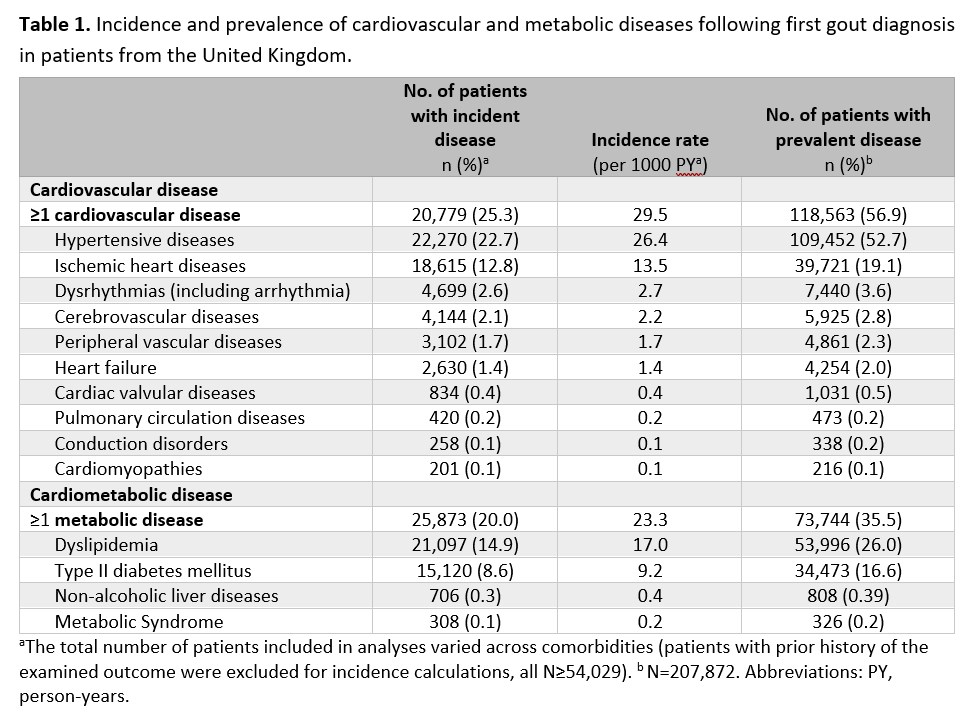Session Information
Date: Sunday, November 12, 2023
Title: (0229–0251) Metabolic & Crystal Arthropathies – Basic & Clinical Science Poster I
Session Type: Poster Session A
Session Time: 9:00AM-11:00AM
Background/Purpose: Gout is a common inflammatory arthropathy characterized by pain, joint swelling, and monosodium urate crystal deposits in joints, organs, and soft tissues.1 While gout is associated with cardiometabolic disorders, there is limited data on comorbidity burden in gout patients and almost no data on their longitudinal development.1 This study aimed to estimate the incidence and prevalence of cardiometabolic disease in patients with gout in the United Kingdom (UK).
Methods: Using The Health Improvement Network (THIN) Database (A Cegedim Proprietary Database), a cohort of patients with a first gout diagnosis between January 1, 2003 and December 5, 2021 was analyzed. Patients were excluded if death occurred before first gout diagnosis, last data point was after last data-cut or before first gout diagnosis, the patient was < 18 years old at first gout diagnosis, or there was a prior history of congenital, toxin-related, or infectious cardiovascular disease (CVD). For incidence calculations, patients with prior history of the examined condition were excluded. Patients were followed from gout diagnosis until earliest of death, database disenrollment, or last available data. Gout and outcome diagnoses were identified using Read codes (clinical terminology system used in the UK), with ≥2 codes required ≥30 days apart to minimize identified comorbidity misclassification. Prevalence (in %) and incidence (in % and rate/1,000 person-years [PY]) of gout-associated cardiometabolic diseases (Table 1) were calculated. This work uses data provided by patients and collected by the NHS as part of their care and support.
Results: A total of 207,872 patients (74.9% male; 47.9% white [N=106,304 with known race]) were included in analyses. At first gout diagnosis, median [interquartile range, IQR] age was 61.7 [49.1, 73.5] years and BMI was 29.0 [25.9, 32.7] kg/m2. 57.0% had >1 CVD code (median [IQR] follow-up: 2.6 [0.7, 8.4] years) and 35.5% had >1 metabolic disease code (5.4[1.6, 10.7] years) after gout diagnosis. In patients without a pre-gout cardiovascular code, >1 CVD code was identified in 25.3% of patients (median [IQR] follow-up: 8.0 [3.9, 12.8] years) for an overall incidence of 29.5/1000 PY after gout diagnosis. In patients without a pre-gout metabolic disease code, >1 metabolic disease code was identified in 20.0% of patients (median [IQR] follow-up: 7.9 [3.8, 12.9] years) for an overall incidence of 23.3/1000 PY after gout diagnosis. The incidence and prevalence of individual conditions are summarized in Table 1.
Conclusion: In the first 8 years after initial gout diagnosis, approximately 1 in 4 patients without prior cardiovascular disease developed a new cardiovascular comorbidity and 1 in 5 patients without prior metabolic disease developed a new metabolic comorbidity. Further, the overall prevalence of cardiovascular and metabolic disease was high in this UK gout population, with hypertension and ischemic heart disease of notable frequency among both incident and prevalent cohorts. Comorbidity development over time will be further explored in and compared between controlled and uncontrolled patients to examine potential contributions of gout.
Reference
1. Bardin, et al. BMCMedicine 2017;15: 1-10.
To cite this abstract in AMA style:
Garshick M, Patel H, Kumar a, LaMoreaux B, Padnick-Silver L, Dron L, Kalatharan V, Verma V, Pillinger M. Incidence and Prevalence of Cardiovascular and Metabolic Diseases Following Gout Diagnosis in the United Kingdom Using the THIN Database [abstract]. Arthritis Rheumatol. 2023; 75 (suppl 9). https://acrabstracts.org/abstract/incidence-and-prevalence-of-cardiovascular-and-metabolic-diseases-following-gout-diagnosis-in-the-united-kingdom-using-the-thin-database/. Accessed .« Back to ACR Convergence 2023
ACR Meeting Abstracts - https://acrabstracts.org/abstract/incidence-and-prevalence-of-cardiovascular-and-metabolic-diseases-following-gout-diagnosis-in-the-united-kingdom-using-the-thin-database/

